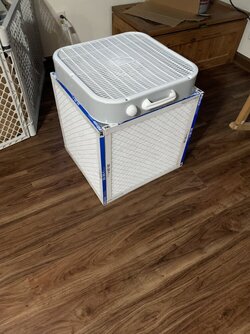I know you folks in the north east USA are seeing some bad air quality. I am really having to dig past the "AQI" numbers to see your actual particle counts in micrograms per cubic meter, but I am starting this thread to encourage you to go find them.
Micrograms per cubic meter is useful data. The breakpoints for how many particles = excellent, good, or hazardous is a moving target because the EPA changes the formula every few years.
Besides the USA EPA breakpoints to covert from mcg/m3 to AQI, WHO has there own table that they use, and the Chinese version of the EPA has their own conversion table too. AQI is freaking useless.
Find your local PM2.5 count in mcg/m3, go outside for a few minutes and say to yourself "this is X many micrograms/ cubic meter."
It is odd to me that you folks in the NE are seeing so much PM2.5 without PM10 in it. Local I am used to PM10 during wild fire season being something like 1/2 to double the PM2.5 count in mcg/m3, it could be that a lot of the PM10 is falling out of the smoke plume between the fire site and your house. In wintertime wood stove burning season in Fairbanks, I am accustomed to seeing the sort of ratio PM2.5/PM10 you folks are seeing right now.
One thing I _think_ I remember is the break point between "good" and "unhealthy for sensitive groups" used to be 50 mcg/m3, currently I am pretty sure it is 35 mcg/m3. So 35 mcg/m3 of PM 2.5 currently returns an AQI of 50, even though on the previous conversion table 35 mcg/m3 would return an AQI of 35.
At the end of the day PM2.5 exposure is bad, and PM 2.5 exposure is inevitable. Less is better. I do have a thread on here somewhere about maintaining indoor air quality during outdoor smoke events.
Micrograms per cubic meter is useful data. The breakpoints for how many particles = excellent, good, or hazardous is a moving target because the EPA changes the formula every few years.
Besides the USA EPA breakpoints to covert from mcg/m3 to AQI, WHO has there own table that they use, and the Chinese version of the EPA has their own conversion table too. AQI is freaking useless.
Find your local PM2.5 count in mcg/m3, go outside for a few minutes and say to yourself "this is X many micrograms/ cubic meter."
It is odd to me that you folks in the NE are seeing so much PM2.5 without PM10 in it. Local I am used to PM10 during wild fire season being something like 1/2 to double the PM2.5 count in mcg/m3, it could be that a lot of the PM10 is falling out of the smoke plume between the fire site and your house. In wintertime wood stove burning season in Fairbanks, I am accustomed to seeing the sort of ratio PM2.5/PM10 you folks are seeing right now.
One thing I _think_ I remember is the break point between "good" and "unhealthy for sensitive groups" used to be 50 mcg/m3, currently I am pretty sure it is 35 mcg/m3. So 35 mcg/m3 of PM 2.5 currently returns an AQI of 50, even though on the previous conversion table 35 mcg/m3 would return an AQI of 35.
At the end of the day PM2.5 exposure is bad, and PM 2.5 exposure is inevitable. Less is better. I do have a thread on here somewhere about maintaining indoor air quality during outdoor smoke events.



